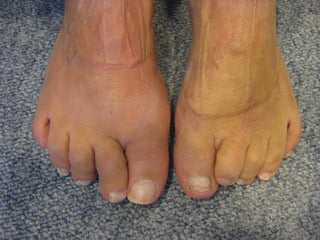Introduction


In some cases, bunion surgery is the only way to correct the deformity of Hallux valgus and restore “normality” to the big toe, not only in terms of appearances but also in terms of function.
Unfortunately bunion surgery has a reputation for being very painful. This is because many older techniques involved destroying the big toe joint and not using any form of fixation when the bones were cut. This would therefore mimic a fracture and not surprisingly caused considerable pain and a long period of recovery.
However, there are many modern types of bunion surgery available now which are more sophisticated and for each patient undergoing bunion surgery there will be an optimal procedure based on the extent of the deformity but also on the lifestyle of the patient.
How does Bunion Surgery work?
At The London Foot and Ankle Centre, we regularly use a procedure called the Scarf Osteotomy. This is a well-established procedure which allows correction of deformity and simultaneous preservation of the normal foot anatomy.
Scarf Osteotomy for bunion correction




Before and after bunion surgery performed at the London Foot and Ankle Centre
The bones are cut and then held in the correct position using screws without heads. This means the metalwork is buried and not palpable through the skin. Because the bones are held securely with the screws the bone ends do not move.
This means that the optimal position can be chosen and maintained but also the rigidity of the fixation helps considerably to minimise pain and swelling after surgery.
All bunion surgery is associated with the potential for stiffness of the big toe and if this is not addressed, the stiffness can persist. Modern techniques use rigid bone fixation, which allows for early mobilisation of the big toe joint.
Physiotherapy is a very important tool in the recovery of patients from bunion surgery. Physiotherapists are able to speed up the recovery process by instituting early mobilisation and working on techniques to reduce swelling.
Physiotherapists specialising in foot and ankle conditions are an integral part of the team at London Foot and Ankle Centre providing support and rehabilitation programmes for patients following surgery for bunions (hallux valgus).
How long will it take to recover?
It takes approximately 4 – 6 weeks for the bone to heal following bunion surgery, and during this time the patient will need to wear a special post-operative shoe, and will be unable to drive.




